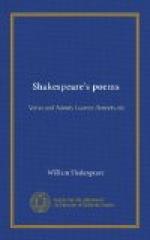|
This section contains 6,838 words (approx. 23 pages at 300 words per page) |

|
SOURCE: Beauregard, David N. “Venus and Adonis: Shakespeare's Representation of the Passions.” Shakespeare Studies 8 (1975): 83-98.
In the following essay, Beauregard addresses the nature of the allegory informing Venus and Adonis and analyzes this issue in terms of the Renaissance theory regarding the sensitive soul and its two parts: the “concupiscible” and the “irascible” powers.
In the past thirty-five years or so, various attempts have been made at defining the meaning of Shakespeare's Venus and Adonis. Lu Emily Pearson early claimed that the poem portrays Venus as sensual love and Adonis as rational love, the final meaning being that “when Adonis is killed, beauty is killed, and the world is left in black chaos.” Similarly, T. W. Baldwin concluded that “Adonis is Love and Beauty, and when he dies Chaos is come again,” adding that Venus in arguing for procreation so that “Love-Beauty-Adonis may not die” is a benevolent...
|
This section contains 6,838 words (approx. 23 pages at 300 words per page) |

|


